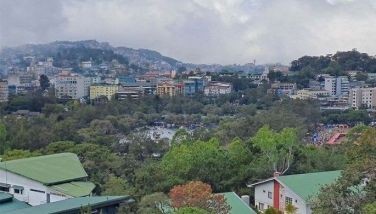Typhoon Nona kills 11, displaces hundreds
MANILA, Philippines - Eleven people were killed and hundreds were evacuated as floods generated by Typhoon Nona inundated villages, disaster officials said yesterday.
The province of Mindoro reported the highest casualty at four with Samar, Catanduanes and Sorsogon reporting two each and one from Masbate, according to the National Disaster Risk Reduction and Management Council (NDRRMC).
Typhoon Nona (international name Melor) had paralyzed Manila by late Tuesday, with floodwaters four feet deep in some areas and causing traffic gridlocks on major roads.
Nona weakened further yesterday but continued to dump rains over Luzon, including Metro Manila, the state weather bureau said.
The NDRRMC said a total of 165,554 families or 742,991 people mostly living along coastal, flood and landslide-prone areas were moved to safer ground under preemptive evacuation in 14 provinces in Eastern Visayas, Bicol and Mindoro, Marinduque, Romblon and Palawan (Mimaropa) regions.
Some 225,994 persons or 50,598 families are in 716 evacuation centers.
The NDRRMC said the initial damage assessment showed Nona has destroyed P160 million worth of agricultural products as well as government and private infrastructure in Eastern Visayas and the Bicol region, not including those in the badly hit Romblon, Marinduque and Romblon provinces.
Nona’s strong winds also destroyed or damaged a total of 3,155 houses in Eastern Visayas, Bicol and Mimaropa.
Damaged infrastructure hit P2.8 million, the NDRRMC said.
Five cities and 100 towns in four provinces of Southern Tagalog, Bicol and Eastern Visayas were plunged in total darkness by Nona’s powerful winds.
However, power was restored in two cities and 38 towns, the NDRRMC said.
A total of eight roads and one bridge were not passable in Mimaropa, Bicol and Eastern Visayas as of yesterday.
In Mindoro Oriental, provincial disaster officials said it might take weeks or even months before power is restored in the island province as Nona toppled most of the electric posts around the province and also fruit bearing trees.
While Nona has weakened and was tracked to be heading toward the West Philippine Sea, the northern part of Occidental Mindoro, including Lubang Island, was still experiencing heavy rains and strong winds as of yesterday.
The Philippine Atmospheric, Geophysical and Astronomical Services Administration (PAGASA) maintained storm warning signal No. 2 over Bataan, Southern Zambales, Cavite, Batangas and Lubang Island as of 5 p.m. yesterday.
Signal No. 1, on the other hand, remained hoisted in Metro Manila, the rest of Zambales, Pampanga, Bulacan, Tarlac, Rizal, Laguna, Northern Occidental Mindoro and Northern Oriental Mindoro.
PAGASA weather forecaster Aldczar Aurelio said Nona would continue to bring moderate to heavy rains in areas within its 250-kilometer diameter.
Aurelio said Nona is expected to weaken further in the next few days due to the intrusion of the cold northeast monsoon.
As of 4 p.m. yesterday, the eye of Nona was located at 70 km southwest of Subic Bay Metropolitan Authority (SBMA) in Olongapo City, Zambales, with maximum sustained winds of 100 kilometers per hour near the center and gustiness of up to 130 kph.
It is forecast to move northwest at seven kph.
Nona is expected to weaken into a low-pressure area as it exits the Philippine area of responsibility on Saturday.
Aurelio said most parts of Luzon and the Visayas, including Metro Manila, can expect improvement in weather condition beginning this afternoon, apart from light rains from the northeast monsoon, which was enhanced by Nona.
Classes, however, remained suspended as of yesterday in typhoon hit areas.
Restorations
The typhoon replenished major reservoirs in Luzon, including Angat Dam in Bulacan.
PAGASA said the water level at Angat Dam was recorded at 210.90 meters, nearing its spilling level of 212 m as of 6 a.m. Wednesday.
The water level at San Roque Dam in Pangasinan also increased to 279.12 m, nearing its 280 m spilling level.
Binga Dam in Benguet was at 574.20 m, close to its spilling level of 575 m.
Ambuklao Dam in Benguet was at 749.40 m, just .57 below its spilling level of 752 m.
Ipo Dam in Bulacan was at 100.44 m, close to its spilling level of 101 m.
Meanwhile, the low-pressure area spotted over the Pacific Ocean developed into a tropical depression and was forecast to enter the Philippine area of responsibility yesterday afternoon.
Aurelio gave assurance there is no possibility of a “Fujiwhara effect” or an interaction between Nona and the new tropical cyclone east of the country.
“They (Nona and the tropical depression) don’t have the same strength and Nona is already far,” Aurelio said.
The approaching cyclone will be given the local name Onyok once inside the Philippine area of responsibility.
As of 4 p.m. yesterday, the center of Onyok was estimated at 860 km east of Mati City, Davao Oriental packing winds of 45 kph. It is forecast to move west northwest at 20 kph.
Aurelio said Onyok is expected to make landfall over the Caraga region tomorrow afternoon.
“It will start to affect eastern Mindanao beginning Thursday or Friday,” he said.
Onyok is forecast to exit the Philippine area of responsibility on Sunday.
The Philippine Coast Guard (PCG), for its part, has placed its operations on heightened alert level three days ahead of Onyok.
Globe Telecom said it has started to restore cell sites in areas affected by Nona to help facilitate delivery of relief services.
Among Globe’s cell cites affected by the typhoon were in Southern Luzon and Eastern Visayas. – With Helen Flores, Alexis Romero, Louella Desiderio, Delon Porcalla, Evelyn Macairan, Non Alquitran, Rainier Allan Ronda, Celso Amo, Ricky Bautista, Ramon Efren Lazaro, Ric Sapnu
- Latest
- Trending
































